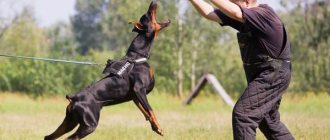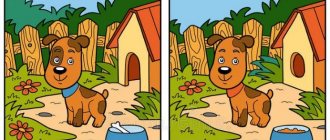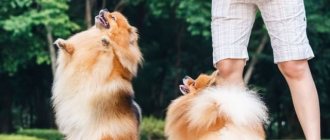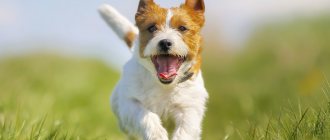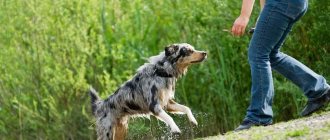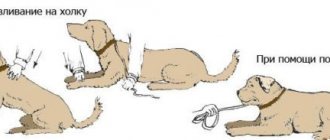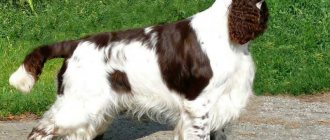At what age do you start training?
Puppy training must begin from the very first days
the presence of a dog in your home. Because already from infancy, the puppy must learn the rules of behavior in your house, what is allowed and what is forbidden, how to behave with all family members, even the smallest and oldest, what he can play with and what he can’t, where to go. toilet and much more.
And we are talking, first of all, about the proper upbringing of a bull terrier puppy, and you can start training and learning commands when the puppy is completely comfortable in your home. As a rule, one week is enough. By this time, the puppy is already filled with curiosity and is diligently exploring the world around him. If, after this time, the puppy remains fearful and does not make contact well, then it is better to seek help from a dog handler-animal psychologist, because This behavior is not typical for puppies of this breed.
When can you start training with a dog handler?
The beginning of the puppy's training coincides with the time of the first exit to the street. When the first two vaccinations have already been done, the quarantine (lasts 7-14 days, depending on the vaccination) after them is over. It is not at all necessary to train your puppy only outside; the first sessions are best done at home, where there are fewer distractions.
Often new puppy owners worry that training from the first days will be excessively stressful for the dog. This is only possible if outdated, rigid methods are used, and with the right approach, training from the first days will, on the contrary, be very useful, since it allows you to immediately establish contact
with the puppy and build a trusting relationship.
You can start raising a puppy from the first days of its appearance in your home, and training and classes with a dog handler can begin simultaneously with the start of walks, when quarantine ends after the second vaccination.
Why you don't need to wait up to 6 months
You often hear that bull terriers, like other dogs, cannot be trained before 6 months, because training is stressful. This opinion remains from the times of outdated methods based on cruel coercion and intimidation of the dog. Unfortunately, there are still plenty of dog handlers using similar techniques today. But fortunately, science does not stand still and modern techniques make it possible to train a puppy from the first days in a new home. Therefore, you should not wait until unwanted behavior has become established in your bull terrier puppy; you can start training much earlier.
Origin of the breed
In England, boules were closely associated with the concept of “blood sport”. Fights existed between people and between animals, including dogs. From the 13th century to the 18th century, brutal massacres were considered entertainment for the crowd, and were even recognized as a national sport.
The history of the mini bull terrier cannot be called pleasant. Smaller individuals are bred on the basis of larger brethren that appeared earlier. The ancestors of the pets are bulldogs and terriers.
In the battles, a separate direction stood out - “bull-baiting”. Small, muscular pets could cope with the bull. Having grabbed the bull's nose, the dog did not let go of his opponent until the last moment. For this purpose, boules were bred - the name of the breed is consonant with the English word “bull”. There is information that the first battle of this kind took place back in 1209.
The living conditions of a bull terrier fighting with bulls were at a low level. The main positive quality of the animal was its grip and ability to win in battles. The rest of the pet's characteristics were ignored. In 1835, bull baiting was banned - the popularity of fighting was declining. The creator of the modern type of breed, James Hinks, soon began to improve the qualities of the dog.
Now the animals were used in dog fighting and rat catching. The white color and unusual shape of the head were able to attract people's attention. The small bull terrier first appeared in 1914 at a London exhibition. But the dogs suffered from genetic diseases; their miniature size was considered a defect. The Mini Bull was recognized as a separate breed only in 1939.
Bull Terriers are the unofficial symbol of Oxford University in England. The teachers consider it good form to have this purebred puppy.
Training at 2 months. Upbringing
At 2 months old, your bull terrier puppy is still at home, in quarantine after the first vaccinations, and he is not yet allowed to go for walks. Therefore, it’s time to start raising a puppy in the home conditions that are already familiar to him.
Toilet training
The first step is teaching the puppy to go to the toilet in a diaper . You should not rush to teach going to the toilet directly outside, bypassing this stage, because puppies are not physiologically ready for walking twice a day. Bull Terrier puppies develop this ability no earlier than 6 months, and in some up to 1 year.
It should be remembered that any learning is a rather complex thing and, seeing the first positive results, you should not think that your puppy has already understood everything, but you should continue training according to the method, so that after a while you do not have to start all over again.
Collar and leash training
The second important point will be to accustom the puppy to a collar and leash . Yes, yes, this should be done at home, so that by the time the puppy goes outside for the first time, wearing a collar will not be additional stress for him, but is already a familiar thing, and he can start exploring the world around him, rather than trying to get rid of an unknown object.
What to allow a puppy and what not
The third point, which causes the greatest difficulty for new puppy owners, will be determining the puppy’s boundaries of what is permitted. Often, many novice dog owners think that the unwanted behavior of a bull terrier puppy will “go away on its own, outgrow it.” But, unfortunately, the behavior that is allowed for a puppy will be taken for granted later by an adult dog.
.
Any unwanted behavior in a puppy WILL NOT go away on its own, but will only become stronger over time.
Therefore, it is necessary to start defining the puppy’s boundaries of what is permitted now. You will need:
- Teach to play only with your toys, and not with your things;
- Explain that you cannot bite your hands even in a game;
- Establish the correct daily routine, establishing the rule that in the morning you need to sleep and not wake you up;
- Stop chewing furniture, clothes, walls and baseboards;
- Teach to stay home alone, knowing that your absence is not a reason to bark or howl.
IT IS EXTREMELY IMPORTANT TO KNOW: constant and excessive punishments that follow almost every action of a puppy have a detrimental effect on its fragile psyche and can lead to the bull terrier puppy growing up cowardly and embittered. For normal natural development, a puppy must have the opportunity to explore the world around him, which is currently limited to your apartment or house.
Introduction to Basic Commands
Already now you should begin to familiarize yourself with the initial obedience commands in a light playful form, while focusing on rewards for execution, because the puppy’s psyche is still quite plastic and excessive severity and exactingness can lead to the puppy being intimidated and cowardly. Therefore, it is necessary, first of all, to try to interest the puppy by offering him a toy or treat, and sometimes just praise.
Breed standard
The lifespan of a Bull Terrier at home is 11–14 years. The dog is strongly built, hardy, and has a confident appearance. A pet would be an excellent choice for athletic people. The English Bull can become a companion on morning or evening runs.
The breed standard is as follows:
- Head. The egg-shaped skull shape is considered standard. The top of the head between the ears is flat. The pet's ears are small, thin, and stand parallel to each other.
- Muzzle. The convex bridge of the nose goes down towards the end. The pet's nose is black.
- Eyes. The pet's eyelids are narrow, slanting, and shaped like a triangle. The eye sockets are set deep, distant from the nose at a great distance.
- Jaws. Scissor bite. The teeth are strong, healthy white, 42 in number. The dog has a deep lower jaw.
- Neck. It tapers from the body to the head, is strong, and has no folds. When viewed from the side, the neck is slightly arched.
- Torso. Broad chest, pronounced curve of rounded ribs. The dog has a deep body from the withers to the chest, and a medium belly.
- Limbs. The paws are strictly parallel to each other in front, at the back - slightly at an angle. The paw pads are rounded. The limbs have developed muscles.
- Tail. Short, set low, slightly tapering from the base to the end. The pet raises its tail horizontally.
The dog's irises should be dark brown. A light shade of a puppy's irises is considered a disqualifying sign.
The traditional color is the white bull terrier. Colored and black colors were developed later, but are included in the standard. If the coloring contains colored elements, the amount of color should exceed white. Skin pigmentation is allowed on the ears and head.
Training at 3 months. Socialization
Three months is an important stage in a bull terrier puppy’s introduction to the outside world. Your first walks should be short and not too tiring for the puppy. You should start with 15 minutes, gradually increasing the walking time to 1 hour.
Correct formation of the nervous system
At this age, the puppy’s nervous system is forming.
. It has been proven that raising puppies in isolation during this important period contributed to the development of pronounced cowardice in them later. It is necessary to show the puppy as much as possible: noisy streets, large crowds of people, etc. Everything that he will have to face in later life.
This must be done very carefully, gradually, over and over again increasing the time spent in noisy places, so as not to overload the puppy or frighten him.
The territory of a country house, cottage or village are places with a minimum amount of external stimuli for a city dog. Therefore, if you plan to keep a dog in an urban environment, “growing up” a bull terrier puppy in such conditions depleted of irritants is unacceptable.
A city puppy must grow up in the city, in conditions that are saturated with external stimuli, such as: noisy streets, large crowds of people, other animals, birds, cyclists, cars, etc.
Meeting people and dogs
It is necessary to introduce the puppy to friendly dogs and people
so that later the puppy does not develop aggression or cowardice caused by the fear of new things and the inability to communicate and make new acquaintances. Currently, unfortunately, this is not uncommon in the behavior of adult dogs, but a fairly common problem with which people turn to our specialists for help.
Puppy behavior on the street
The emergence of new places leads to new rules that need to be consolidated:
- Now you can and should go to the toilet on the street, and not stoically endure it, carrying everything home;
- Not every new person or dog wants to communicate, so you don’t need to run headlong to meet everyone;
- Not all food is healthy, so it should only be taken from the owner’s hands.
Training and practicing commands
Training a puppy follows the same principles as at 2 months. It should be remembered that at this age puppies develop conditioned reflexes quite easily, but they are forgotten just as quickly, so you should not scold the puppy for not following commands, especially if they have not been repeated for a long time, but you should pay more attention to learning new things and repeating already covered material .
Raising a baby
A puppy of this breed, bred for dog fighting, as soon as it appears in the house, can try to dominate and set its own rules. If disobedience is not stopped, then the owner will have to forget about the role of leader in the future forever. A person who is soft in character and unable to cope with emotions should not have such a dog. Nervousness, breakdown, screaming will become a signal for the animal about the weakness of the owner, and he will immediately lose his leadership position.
How to train a bull terrier? It is important to be consistent in parenting, to show patience and perseverance. Rules of behavior must be established once, not changed and strictly observed. The main ones include:
- Determining a place to sleep, eat and rest. Categorical suppression of the animal’s attempts to sleep in the owner’s bed, since the best and most comfortable sleeping place should belong to the leader.
- A puppy is prohibited from showing aggression near his bowl: if at a young age such behavior causes affection, then it is important to remember how this can turn out with an adult dog when a child, for example, ends up next to the bowl.
- If signs of aggression or dissatisfaction appear, the puppy is strictly reprimanded and pointed to his bed.
- Do not allow the dog to be present at the owners’ dinner, much less receive food from the table. They feed her last.
- The puppy’s toys are also the property of the owner; determining the time to play with them is also the prerogative of the owner. The puppy should not react aggressively to an attempt to pick them up. If the dog is not intended for official purposes, then you should not pull the toy with him: if the dog does not give it back, shake your pet by the scruff of the neck and scold him. When the dog spits it out, the animal is taken away and only after that the toy is picked up. This trick is difficult to do with an adult bull terrier. In this case, they resort to using a leash and a strict collar or wait until he spits out the toy himself. It is then picked up and put away forever. Only the owner should determine how much, with what and when his four-legged friend will play.
- The same can be said about caresses. If a dog forces you to pet it frequently while its owner is busy doing something, this indicates an attempt at dominance. In this case, the “Lie down” command is considered the best option. After that, continue with your business.
- Bull Terriers treat strangers calmly. If the owner himself does not bait the puppy, then he usually shows restrained curiosity. It’s another matter if there is a struggle for leadership between a person and a puppy: the animal should be made to understand: it is the owner’s right to determine the target for attack.
- If the bull terrier behaves inappropriately, they are taken to another room. Don’t forget about the little things: when walking and going down stairs, the dog should walk next to the person, and not in front. In the event of a collision at the threshold, the dog must retreat.
Training at 4 - 5 months
By this time, the bull terrier puppy has already become accustomed to your home and usual walking areas, and no longer needs your support and care so much. He begins to flirt with other dogs, pretend that he does not hear you when you call him, and show a certain persistence and disobedience when performing various commands.
This means it's time to move on to full training . In classes at this age you can already be persistent and demanding. At the same time, the most important thing is not to overdo it, remember that classes should bring joy to both you and your dog, and only then you can achieve the desired result.
Required commands in 4 months
What commands are practiced in a bull terrier puppy at 4 months:
- Calm movement next
to the owner with and without a leash, with landing when stopping, with a change in pace and direction of movement - Return to you
upon request - Staying
in a free or certain position (sitting, lying, standing) for a long time: if necessary, wait for the owner on the street, when visiting a store or other establishment - Indifferent attitude towards treats scattered on the ground
- Inhibitory command
to stop unwanted actions - Execution of a set of commands “sit”, “lie down”, “stand”
at a distance and near the leg, when giving commands by voice and gestures - Stop barking
on demand.
Bull Terrier decorative
The mini bull terrier looks very much like its “big brother”. However, it is much smaller in size and has a distinctive character. This is a great companion that is suitable for keeping even in small apartments. However, it should be remembered that such a dog loves long walks.
Mini Bull Terriers began to be bred in Great Britain in the 19th century. For this purpose, dwarf puppies were selected, born from the mating of standard dogs. They were raised not for dog fighting, but for catching rats, which were abundant in the houses and streets of old London. In the breeding of mini-bull terriers, in order to consolidate the small size of the animals, Jack Russell terriers and fox terriers were used.
The height of small representatives of the breed does not exceed 35.5 centimeters. There are no restrictions on weight, as with standard animals, but it must correspond to height. A torso that is too fat or too thin is undesirable.
When a miniature bull terrier is in motion, it is striking how harmoniously and firmly built it is. These dogs also have coarse and short hair. The standard allows the following colors: white with spots on the head, red, brindle with a predominant black, tricolor, fawn. If you are wondering which dog to choose for your child, then, of course, a mini bull terrier will do.
Training from 6 months
At this age, the puppy begins puberty and the real rebel awakens in him. He begins to re-test the boundaries of what is permitted and, sometimes, deliberately does not respond to your commands, only in order to look at your reaction. If she is not what the puppy expects to see, then he may decide that now he can no longer carry out your commands.
Remember that a puppy is still a child.
, and excessive harshness can forever undermine his trust in you.
At this stage of the bull terrier puppy's growing up in training, all the shortcomings made at the previous stages, which were smoothed out by his young age, become clearly visible. And if they appear, it’s time to correct them.
In many training schools, there is an opinion that a puppy needs to be trained in two stages, the first at an early age, and the second at 8 - 10 months, in order to “consolidate” what has been learned. This is not an entirely correct position; this opinion appeared when newer operant training methods began to be added to the old “DOSAAF” rigid training methods, where they began to work with the puppy strictly after 6-7 months, including working with the method of pointing and following the “target”.
Their weakness was that they were two different techniques.
, which began to be used without adapting to each other, having a huge gap between their tools for developing training skills. The difference between them is like between choreography lessons in kindergarten and army drill training. Therefore, they required training in two stages, which were in no way connected with each other.
Modern methods based on zoopsychology make it possible to train a puppy in a single system , when no additional stages of training are required.
Owner reviews
Most owners who have bull terriers in their homes are satisfied with their companions. However, they advise those who are just planning to have such a pet to pay great attention to its early socialization and upbringing - the character of the Bull Terrier in the future depends on this. If there is a child in your family, then you don’t have to worry about his safety: these dogs are very kind and gentle towards children. True, you should be careful with very young children: a powerful dog can accidentally push the child. At the same time, he will never show aggression towards him. However, in this case it is more advisable to get a mini bull terrier.
Source: fb.ru
Our dog handlers
bull terrier training specialists
Alexander Chaplygin Dog psychologist-zoopsychologist
Experience: 37 years Read more..
Ekaterina Panova Dog psychologist-zoopsychologist
Experience: 34 years Read more..
Yaroslav Morozov Dog psychologist-zoopsychologist
Experience: 25 years Read more..
Lada Yurtseva Dog psychologist-zoopsychologist
Experience: 21 years Read more..
Victoria Fox Dog psychologist-animal psychologist
Experience: 14 years Read more..
Ekaterina Budkina Dog psychologist-zoopsychologist
Experience: 13 years Read more..
Evgeniy Bravinsky Dog psychologist-zoopsychologist
Experience: 17 years Read more..
Vitalia Bravinskaya Dog psychologist-zoopsychologist
Experience: 10 years Read more..
Kira Ageeva Dog psychologist-zoopsychologist
Experience: 19 years Read more..
Evgenia Zuber Dog psychologist-zoopsychologist
Experience: 12 years Read more..
Tatyana Melnikova Dog psychologist-zoopsychologist
Experience: 10 years Read more..
Alexey Melikhov Dog psychologist-zoopsychologist
Experience: 22 years Read more..
* Check with the managers for the possibility of a specific specialist visiting the area you specified. If the desired dog handler does not work in your area, then we can offer you another specialist from the above.
Average cost of a puppy
English bull terrier puppies cost at least 45 thousand Russian rubles. The price from hands and from breeders varies greatly. The latter provide the necessary documentation for the dog. The cost of a pet with a pedigree can rise higher.
Purchasing from a foster home is a guarantee that the animal will be healthy and vaccinated. You definitely need to check how your pet reacts to the voice. Deafness is a congenital defect.
The main criterion determining the price is compliance with standards. If the puppy does not participate in exhibitions, you can buy a pet cheaper. When purchasing a puppy, it is important to meet with the parents of the little boules. It is advisable to evaluate the living conditions of pets.
Training a bull terrier puppy in
When you turn to our canine center for help in training a bull terrier puppy, you can be sure that a real specialist in his field
and will provide training at the proper, highest level.
- A dog trainer will come to your
home at a time convenient for you. - Classes are held 1-2 times a week
, depending on the program. - Instructors work from 9:00 to 21:00
, on weekends inclusive - The training program is drawn up at the first lesson,
taking into account the breed, age, personal characteristics of the dog and your wishes for training - Some classes take place at home
, some
outside
, depending on the topic of the lesson. - Puppy age
from 2 months
Our Center employs dog handlers - animal psychologists who have experience in working with bull terrier puppies and training adult dogs from 10 to 35 years old, who know all the nuances of their behavior
and features of training at each stage of a dog’s growth. Therefore, your pet is guaranteed to learn to carry out your commands the first time in any conditions, and will become your faithful and reliable companion.
Features of the English Bull Terrier breed
It is imperative to take a training course . They are poorly trained due to their stubbornness. When training, you should never hit or punish the dog, as it may become withdrawn and start snapping. It is best to contact specialists who will help you with raising your pet. When training, you need to be patient, persistent and not give up. It can be trained through play and treats. If you do everything right, you will get an obedient dog who will be loyal to you for the rest of his life.
Dog health
Despite the fact that bull terriers are distinguished by excellent health and live for 12-15 years, they are prone to the following diseases: dislocation of the kneecap, congenital deafness, hip dysplasia, polycystic kidney disease, allergies (primarily food), lethal acrodermatitis, cancer. , obesity.
Proper feeding and competent care, which also includes timely worming and vaccination, can extend the years of life of a four-legged pet.

